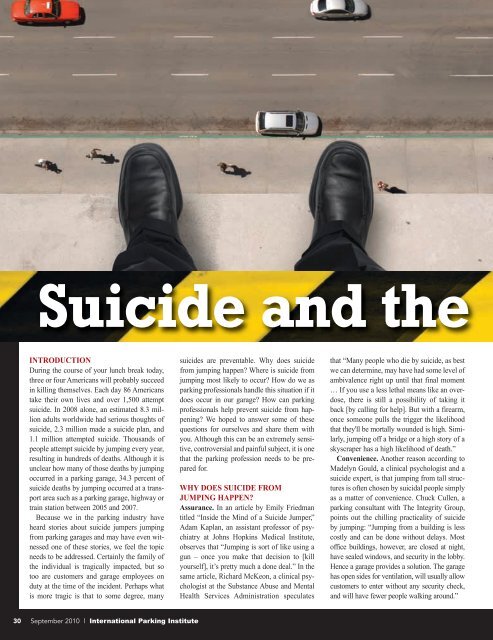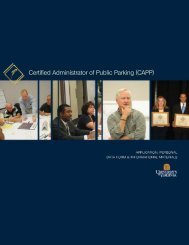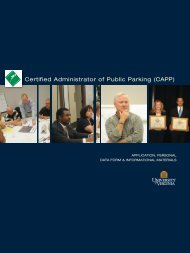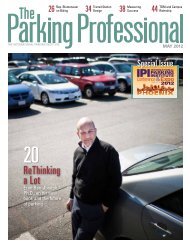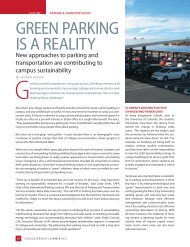Suicide and the - International Parking Institute
Suicide and the - International Parking Institute
Suicide and the - International Parking Institute
Create successful ePaper yourself
Turn your PDF publications into a flip-book with our unique Google optimized e-Paper software.
<strong>Suicide</strong> <strong>and</strong> <strong>the</strong><br />
INTRODUCTION<br />
During <strong>the</strong> course of your lunch break today,<br />
three or four Americans will probably succeed<br />
in killing <strong>the</strong>mselves. Each day 86 Americans<br />
take <strong>the</strong>ir own lives <strong>and</strong> over 1,500 attempt<br />
suicide. In 2008 alone, an estimated 8.3 million<br />
adults worldwide had serious thoughts of<br />
suicide, 2.3 million made a suicide plan, <strong>and</strong><br />
1.1 million attempted suicide. Thous<strong>and</strong>s of<br />
people attempt suicide by jumping every year,<br />
resulting in hundreds of deaths. Although it is<br />
unclear how many of those deaths by jumping<br />
occurred in a parking garage, 34.3 percent of<br />
suicide deaths by jumping occurred at a transport<br />
area such as a parking garage, highway or<br />
train station between 2005 <strong>and</strong> 2007.<br />
Because we in <strong>the</strong> parking industry have<br />
heard stories about suicide jumpers jumping<br />
from parking garages <strong>and</strong> may have even witnessed<br />
one of <strong>the</strong>se stories, we feel <strong>the</strong> topic<br />
needs to be addressed. Certainly <strong>the</strong> family of<br />
<strong>the</strong> individual is tragically impacted, but so<br />
too are customers <strong>and</strong> garage employees on<br />
duty at <strong>the</strong> time of <strong>the</strong> incident. Perhaps what<br />
is more tragic is that to some degree, many<br />
30 September 2010 l <strong>International</strong> <strong>Parking</strong> <strong>Institute</strong><br />
suicides are preventable. Why does suicide<br />
from jumping happen? Where is suicide from<br />
jumping most likely to occur? How do we as<br />
parking professionals h<strong>and</strong>le this situation if it<br />
does occur in our garage? How can parking<br />
professionals help prevent suicide from happening?<br />
We hoped to answer some of <strong>the</strong>se<br />
questions for ourselves <strong>and</strong> share <strong>the</strong>m with<br />
you. Although this can be an extremely sensitive,<br />
controversial <strong>and</strong> painful subject, it is one<br />
that <strong>the</strong> parking profession needs to be prepared<br />
for.<br />
WHY DOES SUICIDE FROM<br />
JUMPING HAPPEN?<br />
Assurance. In an article by Emily Friedman<br />
titled “Inside <strong>the</strong> Mind of a <strong>Suicide</strong> Jumper,”<br />
Adam Kaplan, an assistant professor of psychiatry<br />
at Johns Hopkins Medical <strong>Institute</strong>,<br />
observes that “Jumping is sort of like using a<br />
gun – once you make that decision to [kill<br />
yourself], it’s pretty much a done deal.” In <strong>the</strong><br />
same article, Richard McKeon, a clinical psychologist<br />
at <strong>the</strong> Substance Abuse <strong>and</strong> Mental<br />
Health Services Administration speculates<br />
that “Many people who die by suicide, as best<br />
we can determine, may have had some level of<br />
ambivalence right up until that final moment<br />
… If you use a less lethal means like an overdose,<br />
<strong>the</strong>re is still a possibility of taking it<br />
back [by calling for help]. But with a firearm,<br />
once someone pulls <strong>the</strong> trigger <strong>the</strong> likelihood<br />
that <strong>the</strong>y'll be mortally wounded is high. Similarly,<br />
jumping off a bridge or a high story of a<br />
skyscraper has a high likelihood of death.”<br />
Convenience. Ano<strong>the</strong>r reason according to<br />
Madelyn Gould, a clinical psychologist <strong>and</strong> a<br />
suicide expert, is that jumping from tall structures<br />
is often chosen by suicidal people simply<br />
as a matter of convenience. Chuck Cullen, a<br />
parking consultant with The Integrity Group,<br />
points out <strong>the</strong> chilling practicality of suicide<br />
by jumping: “Jumping from a building is less<br />
costly <strong>and</strong> can be done without delays. Most<br />
office buildings, however, are closed at night,<br />
have sealed windows, <strong>and</strong> security in <strong>the</strong> lobby.<br />
Hence a garage provides a solution. The garage<br />
has open sides for ventilation, will usually allow<br />
customers to enter without any security check,<br />
<strong>and</strong> will have fewer people walking around.”
WHERE DOES SUICIDE FROM<br />
JUMPING MOST COMMONLY<br />
OCCUR?<br />
A simple Google search on “<strong>Suicide</strong> by <strong>Parking</strong><br />
Garage” yielded over two million results.<br />
According to data collected by <strong>the</strong> National<br />
Violent Death Reporting System (NVDRS),<br />
<strong>the</strong> most common circumstances among people<br />
who died by suicide from jumping was<br />
mental illness. Nearly 60 percent had a current<br />
mental health problem <strong>and</strong> nearly 53 percent<br />
had been previously treated for a mental health<br />
condition. Therefore, hospital parking operations<br />
are highly prone to suicide by jumping. A<br />
parking professional from a hospital in <strong>the</strong><br />
Midwest shared <strong>the</strong> following story with us:<br />
“In 2009, a psych patient from [our hospital]<br />
asked to go for a walk with his family. He<br />
went to <strong>the</strong> roof of an adjacent parking<br />
garage <strong>and</strong> jumped five stories to his death,<br />
onto a bike rack full of bikes. The bike rack<br />
<strong>Parking</strong> Garage<br />
was located approximately 100 feet from one<br />
of our hourly cashier booths with one of our<br />
employees inside …The person jumped off<br />
<strong>the</strong> garage while [his] son <strong>and</strong> wife stood<br />
next to him.” A study conducted in June 2009<br />
by <strong>the</strong> Office of Mental Health depicts suicide<br />
by jumping <strong>the</strong> number one method of<br />
sentinel event (SE) suicide. Office of Mental Health<br />
<strong>Suicide</strong> is <strong>the</strong> second-leading cause of death<br />
among college students, which makes campus<br />
parking operations prone to suicide by<br />
jumping. Between 1952 <strong>and</strong> 1995, <strong>the</strong> incidence<br />
of suicide among adolescents <strong>and</strong> young<br />
adults nearly tripled. More teenagers <strong>and</strong><br />
young adults die from suicide than from<br />
cancer, heart disease, AIDS, birth defects,<br />
stroke, pneumonia, influenza <strong>and</strong> chronic lung<br />
disease, combined. A recent study by <strong>the</strong><br />
American Psychological Association reveals<br />
that over half of American college students<br />
have considered suicide at some points in<br />
<strong>the</strong>ir lives. By contrast, only 15.3 percent of<br />
Americans have contemplated suicide. The<br />
study indentified increasing levels of stress<br />
among college students with diminishing<br />
resources to h<strong>and</strong>le suicide prevention. However,<br />
one college campus that was continuously<br />
affected by suicide restricted access to tall<br />
buildings, windows, <strong>and</strong> balconies. The<br />
campus alarmed <strong>the</strong> doors leading to rooftops,<br />
installed telephones that dialed 911 directly,<br />
<strong>and</strong> posted hotline numbers at all roof exits.<br />
HOW DO WE AS PARKING<br />
PROFESSIONALS HANDLE THIS<br />
SITUATION IF IT DOES OCCUR IN<br />
OUR GARAGE?<br />
Preparation. Elana Premack S<strong>and</strong>ler, a prevention<br />
specialist with <strong>the</strong> <strong>Suicide</strong> Prevention<br />
Center, states, “Establishing a relationship<br />
with local police <strong>and</strong> first responders<br />
(EMTs, crisis intervention officers) is a first<br />
step. Additionally, participating in or establishing<br />
a relationship with a local or state suicide<br />
prevention coalition can help inform parking<br />
garage managers about what’s happening in<br />
suicide prevention locally or statewide. You<br />
may be able to help increase <strong>the</strong> sources of<br />
support for your staff so that <strong>the</strong>y have a network<br />
of resources to turn to in a crisis. In<br />
addition, <strong>the</strong>se groups should be able to help<br />
parking garage managers develop a protocol<br />
for responding to a suicide.”<br />
Call for Help. Call 911 immediately. For<br />
every suicide death, <strong>the</strong>re are five hospitalizations<br />
<strong>and</strong> 22 emergency department visits.<br />
Of <strong>the</strong> adults who attempted suicide in <strong>the</strong><br />
past year, 62.3 percent (678,000 persons)<br />
received medical attention <strong>and</strong> 46 percent<br />
(500,000 persons) stayed overnight or longer<br />
in a hospital for <strong>the</strong>ir suicide attempts. “Time<br />
is <strong>the</strong> key factor with anyone that has jumped<br />
to commit suicide. If someone witnesses<br />
someone attempt suicide or happens to find<br />
someone that has jumped, <strong>the</strong> first thing <strong>the</strong>y<br />
should do is call 911. It is important not to<br />
move <strong>the</strong> patient until qualified medical personnel<br />
are on <strong>the</strong> scene as this could exacerbate<br />
any injuries. If <strong>the</strong> first person on scene<br />
knows basic life support it would be beneficial<br />
to start <strong>the</strong> process by talking with <strong>the</strong><br />
Isaiah Mouw <strong>and</strong> Andy Troth, CAPP<br />
person <strong>and</strong> checking a pulse on a non-bloody<br />
site unless <strong>the</strong> person has personal protective<br />
equipment. It is a good idea for parking<br />
garage workers to have training in basic life<br />
support <strong>and</strong> have personal protective equipment<br />
nearby (i.e. non latex gloves <strong>and</strong> CPR<br />
mask). With falls from heights, people are at<br />
increased risk for brain, spinal cord or<br />
extremity injuries. The higher <strong>the</strong> fall, <strong>the</strong><br />
greater <strong>the</strong> risk. But with a fall from any<br />
height, <strong>the</strong> person could be at risk for a brain<br />
injury,” warns Robert D. Hales, D.O. In addition<br />
to calling 911 for emergency personnel<br />
to respond, it's also important to consider<br />
legal matters <strong>and</strong> police investigations.<br />
According to Sergeant Anthony Easter of <strong>the</strong><br />
Chattanooga Police Department, “It may be<br />
apparent that a body found on <strong>the</strong> ground next<br />
to a tall structure is a suicide victim, but police<br />
must always consider homicide <strong>and</strong> foul play<br />
as possible cause of death. The medical<br />
examiner's office has to conduct an autopsy to<br />
determine <strong>the</strong> true cause of death <strong>and</strong> must be<br />
contacted in any suicide-by-jumping case.<br />
Police have to establish a crime scene in a<br />
timely fashion in order to secure evidence <strong>and</strong><br />
prevent crime scene contamination.”<br />
The Press. A parking professional in <strong>the</strong><br />
midwest told us that it would be wise to tell<br />
your employees not to comment to <strong>the</strong> press,<br />
but to direct all questions to <strong>the</strong> police<br />
department. The less media coverage, <strong>the</strong><br />
less likely <strong>the</strong> parking facility will become<br />
attractive to o<strong>the</strong>r suicide jumpers. Premack<br />
S<strong>and</strong>ler comments that “Particularly with<br />
high-profile suicides, media coverage can<br />
contribute to contagion, so it is important to<br />
work with <strong>the</strong> media to inform <strong>the</strong> public<br />
without sensationalizing suicide.” The<br />
<strong>Suicide</strong> Prevention Resource Center (SPRC)<br />
offers recommendations on its Web site<br />
(www.sprc.org) for safe reporting on suicide<br />
with media professionals who are interested<br />
in covering a suicide death.<br />
Counseling. If you had employees who<br />
witnessed <strong>the</strong> incident, make sure to talk to<br />
<strong>the</strong> parking professional l www.parking.org/tpp l September 2010 31
your human resource department about offering<br />
counseling or any o<strong>the</strong>r help needed for <strong>the</strong><br />
employees. The Washington D.C. Metro rail<br />
system, following a number of suicides on its<br />
rail system in 2009, launched a partnership<br />
with a local suicide prevention group to help<br />
employees underst<strong>and</strong> <strong>and</strong> cope with <strong>the</strong>ir own<br />
reactions to <strong>the</strong> tragedies <strong>the</strong>y witnessed, as<br />
well as to help <strong>the</strong>m prevent future suicides.<br />
O<strong>the</strong>r transit systems such as <strong>the</strong> Toronto<br />
Transit in Canada <strong>and</strong> <strong>the</strong> Massachusetts<br />
Bay Transit Authority in Boston have used<br />
similar prevention programs. Training for staff<br />
can usually be accessed locally through a<br />
coalition or a non-profit organization focused<br />
on suicide prevention.<br />
HOW CAN WE HELP PREVENT<br />
SUICIDE FROM HAPPENING?<br />
Two effective but costly methods of preventing<br />
suicide by jumping from parking garages are<br />
installing pedestrian access control readers <strong>and</strong><br />
suicide barriers. Having pedestrian access control<br />
readers not only limits v<strong>and</strong>alism in <strong>the</strong><br />
garages, but it could save lives. Several parking<br />
facilities that have had a history of suicide<br />
jumpers have installed suicide barriers such as<br />
netting <strong>and</strong> fencing. Critics of <strong>the</strong> barriers <strong>and</strong><br />
o<strong>the</strong>r such restriction methods argue that a suicidal<br />
person will simply find ano<strong>the</strong>r building to<br />
jump from; however, several studies have found<br />
that putting up a barrier at a popular suicide site<br />
will not drive suicidal individuals to find ano<strong>the</strong>r<br />
site. In this way, a barrier is effective not only<br />
in preventing suicide at one site, but may help<br />
prevent suicide overall in a geographic area.<br />
SOURCES<br />
Berman, Alan L., et al. National Strategy for <strong>Suicide</strong> Prevention: Goals <strong>and</strong> Objectives for<br />
Action. Rockville: Public Health Service, 2001.<br />
Friedman, Emily. “Inside <strong>the</strong> Mind of a <strong>Suicide</strong> Jumper.” ABC News. 2 July 2008. 15 June<br />
2010. http://abcnews.go.com/Health/MindMoodNews/story?id=5294404&page=1.<br />
Friend, Tad. “Letter from California Jumpers.” The New Yorker. 13 October 2003. 15 June<br />
2010. www.newyorker.com/archive/2003/10/13/031013fa_fact?currentPage=1.<br />
Halverson, Julie. “Restricting Access to Lethal Means at Colleges <strong>and</strong> Universities.” Means<br />
Matter. 4 December 2008. 15 June 2010. www.sprc.org/grantees/campus/2009/PDF/<br />
C2BLethalMeansSPRC.pdf.<br />
Hogan, Michael, et al. “Incident Reports <strong>and</strong> Root Cause Analyses 2002-2008: What They<br />
Reveal About <strong>Suicide</strong>.”<br />
June 2009. 15 June 2010. www.omh.state.ny.us/omhweb/statistics/suicide_incident_rpt.<br />
32 September 2010 l <strong>International</strong> <strong>Parking</strong> <strong>Institute</strong><br />
A ra<strong>the</strong>r inexpensive but highly effective<br />
method is training parking structure personnel<br />
to recognize <strong>the</strong> signs of a person thinking about<br />
suicide. Sometimes a person will pace back <strong>and</strong><br />
forth. “Sometimes someone will be obviously<br />
emotional <strong>and</strong> crying. It’s important for staff to<br />
feel comfortable approaching someone <strong>and</strong> asking<br />
if <strong>the</strong>y’re okay,” says Premack S<strong>and</strong>ler. A<br />
parking garage security officer in Houston was<br />
able to save <strong>the</strong> life of a person contemplating<br />
suicide after he noticed a woman leaning over<br />
<strong>the</strong> edge of a parking garage. A parking manager<br />
in Michigan was able to save <strong>the</strong> life of a<br />
person thinking about committing suicide<br />
because he simply recognized <strong>the</strong> individual in<br />
a wheelchair heading towards <strong>the</strong> elevators as a<br />
previous jumper. Kevin Briggs, a patrolman for<br />
<strong>the</strong> Golden Gate Bridge, has coaxed in more<br />
than two hundred potential jumpers without<br />
losing one over <strong>the</strong> side. Simply knowing <strong>the</strong><br />
signs, being alert <strong>and</strong> walking your facilities<br />
could lead to saving a life.<br />
O<strong>the</strong>r ideas are posting prevention signs in<br />
high probability locations such as “Contemplating<br />
<strong>Suicide</strong>? Call 1-800-273-TALK” or “Prevent<br />
<strong>Suicide</strong> Now: 1-800-SUICIDE NOW (1-800-<br />
784-2433).” You can also contact your state for<br />
ideas — State <strong>Suicide</strong> Prevention Plans already<br />
exist or are currently being created in over 20<br />
states. For more information, visit <strong>the</strong> <strong>Suicide</strong><br />
Prevention Resource Center at www.sprc.org.<br />
“While some suicides are carefully planned,<br />
many appear to be more impulsive. If we can<br />
put in place measures during <strong>the</strong> crisis period<br />
that restrict <strong>the</strong> means of suicide, it is even more<br />
preventable. On a large scale, means restriction<br />
can have quite an impact on suicide prevention,”<br />
notes Premack S<strong>and</strong>ler.<br />
CONCLUSION<br />
Every suicide is a tragedy that requires us to<br />
acknowledge its high human cost in anguish<br />
<strong>and</strong> pain <strong>and</strong> take measures to prevent a similar<br />
recurrence. While it may be true that some individuals<br />
cannot be deterred from <strong>the</strong>ir attempts<br />
to kill <strong>the</strong>mselves, many attempts can be<br />
thwarted, allowing troubled people to get help<br />
before making a rash decision <strong>the</strong>y will not be<br />
able to undo. “<strong>Suicide</strong> is preventable. That<br />
message is perhaps <strong>the</strong> most important to convey,<br />
as many believe that suicide is inevitable<br />
for people who are considering suicide,” says<br />
Premack S<strong>and</strong>ler. One of <strong>the</strong> most powerful<br />
stories we came across is that of Kevin Hines,<br />
who jumped from <strong>the</strong> Golden Gate Bridge in<br />
2000. He was pacing <strong>the</strong> bridge back <strong>and</strong> forth,<br />
sobbing. No one asked him if he was okay. “I<br />
was like ‘F*** this, nobody cares.’” He jumped<br />
<strong>and</strong> was one of only twenty-six people out of<br />
<strong>the</strong> estimated 1,200 plus to ever jump off <strong>the</strong><br />
Golden Gate Bridge <strong>and</strong> survive. His first<br />
thought after jumping was: “What <strong>the</strong> hell did I<br />
just do? I don’t want to die.” ■<br />
Isaiah Mouw is a current CAPP c<strong>and</strong>idate <strong>and</strong><br />
works for Republic <strong>Parking</strong> System. He can be<br />
reached at imouw@republicparking.com or<br />
413.231.4411.<br />
Andy Troth, CAPP, is <strong>the</strong> Director of <strong>Parking</strong> &<br />
Transportation at Baylor University Medical<br />
Center. He can be reached at <strong>and</strong>rew.troth@baylorhealth.com<br />
or 214.820.6884.<br />
Johnson, Alex. “Half of college students consider suicide.” MSNBC News. 18 August 2008.<br />
15 June 2010.<br />
www2.universitybusiness.com/newssummary.aspx?news=yes&postid=16547.<br />
Halverson, Julie. “Restricting Access to Lethal Means at Colleges <strong>and</strong> Universities.” Means<br />
Matter. 4 December 2008. 15 June 2010. www.sprc.org/grantees/campus/2009/PDF/2B<br />
LethalMeansSPRC.pdf.<br />
National Survey on Drug Use <strong>and</strong> Health. “Suicidal Thoughts <strong>and</strong> Behaviors among<br />
Adults.” The NSDUH Report. 17 September 2009. 15 June 2010.<br />
www.oas.samhsa.gov/2k9/165/<strong>Suicide</strong>.htm.<br />
Rein, Lisa. “Metro Turns To <strong>Suicide</strong> Prevention Groups for Help.” The Washington Post.<br />
9 September 2009. 15 June 2010. www.washingtonpost.com/wp-dyn/content/article/2009/09/18/AR2009091803429.html


